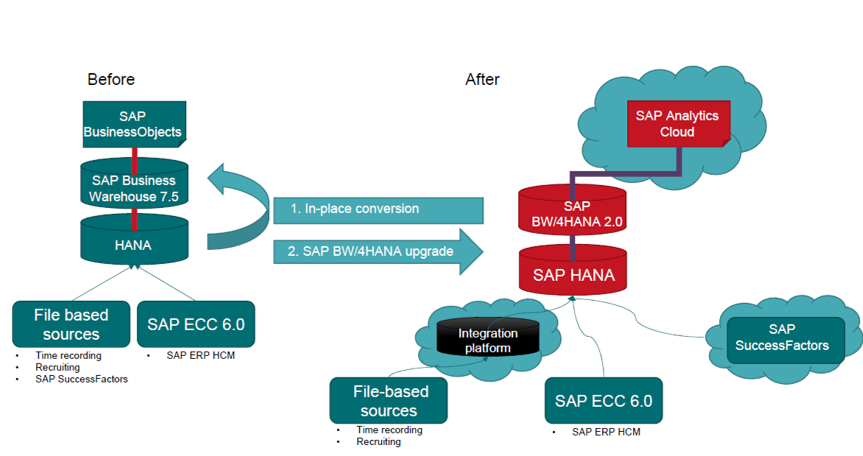Data Warehouse Overhaul Helps Helvetia Simplify Reporting and Analytics for HR — to Start
by Brianna Shipley, Senior Editor, SAPinsider
Data is quickly becoming one of the world’s most valuable resources, but without the ability to store, organize, and interpret data, its value decreases significantly. Data warehouses serve as a central repository for information coming from multiple internal and external sources, enabling businesses to perform reporting and analytics and turn data into insights. For a company like Helvetia Group — which has been insuring products ranging from private and occupational pensions to liability, motor vehicle, transport, and property insurance for more than 160 years — achieving such insights ensures that the company can deliver meaningful and relevant information to its customers in a secure and convenient fashion.
To consistently uncomplicate the growing insurance sector, Helvetia has evolved its footprint and expertise, as demonstrated by the company’s entry into several niche areas such as space and aviation insurance. To serve its broad customer base and increase the organization’s agility and innovation, in 2017 Helvetia implemented a program called Fit4Analytics as part of its larger corporate strategy.
Explore related questions
This strategy is driven by the company’s dedication to simplifying complex insurance and pension topics for customers and its mission to inspire innovation among employees so they can work toward creating simple solutions. Not surprisingly, many of the roads to achieving these aims are digital. For example, Helvetia is taking advantage of intelligent technology and recent advances in artificial intelligence by offering a chatbot service. Customers can immediately report their concerns or damage via a chatbot using their computer, tablet, smartphone, and most recently, WhatsApp.
In 2019, Helvetia founded a new IT division within its Swiss-based customer market management. Coined “data and analytics,” the division was tasked with improving the company’s SAP landscape, specifically around its data warehousing platform. For instance, in one 2018 initiative, Helvetia implemented the SAP HANA appliance to speed its data delivery processes. In its existing SAP landscape, the business is running SAP ERP 6.0 (with plans to begin a migration to SAP S/4HANA in the near future), including SAP ERP Human Capital Management (SAP ERP HCM) on IBM DB2 and some SAP SuccessFactors solutions for HR, as well as SAP Business Warehouse (BW) 7.5 powered by SAP HANA. To update this SAP landscape, Helvetia decided to undertake another initiative to upgrade to SAP BW/4HANA.
SAP BW/4HANA Conversion Supports Helvetia’s Commitment to Simplicity
Helvetia’s Deputy Lead for Business Intelligence, Clemens Groetz, manages the team responsible for two existing SAP BW systems in Helvetia’s agile Swiss-based customer market organization. The larger of the two systems is more than 10 years old and contains the company’s financial data, including data from legal, financial and cost reporting, and all insurance data related to that market. The smaller of the two SAP BW systems contains the company’s HR data prior to 2020, which includes data from SAP ERP HCM, SAP SuccessFactors solutions, and some file-based sources consisting of time recordings, key recruiting figures, exit interview data, and training measures.
Before committing to convert the larger SAP BW system to SAP BW/4HANA, which has many dependencies on other projects and SAP and non-SAP systems, according to Clemens, the company decided to first perform an in-place conversion for the smaller system as a test run. The project team began the conversion of the smaller SAP BW system at the end of January 2020 and concluded the project in March of the same year. The upgrade was completed by following steps in a cookbook created by Clemens, which he says was instrumental to the conversion.
The core conversion team consisted of five people total, all of whom were located in Helvetia’s Swiss headquarters. The preparation phase, according to Clemens, included help from SAP to create the target architecture, provide best practices, and correct error messages occurring in the conversion tools within Helvetia’s SAP BW system.
“This conversion has given us a chance to extend our knowledge about how an existing SAP BW system can be moved to SAP BW/4HANA,” says Clemens. He and his team will also be able to test the integration capabilities between SAP BW/4HANA and SAP SuccessFactors solutions. Helvetia’s 2021 project plan includes an SAP SuccessFactors Employee Central implementation for the company’s Switzerland location, as well as taking advantage of additional functionality within SAP SuccessFactors, such as time recording and learning modules.
To support Helvetia’s mission of delivering simplicity to customers, employees need to be able to achieve data-driven results in a more agile way, according to Clemens. “We’re trying to adopt classical development processes with some aspects of DevOps methods to ensure that users outside the IT department get solutions developed faster. But you need to take care on these changes and ensure that people within and outside of IT don’t get lost during these changes,” he says.
Currently, employees within the data and analytics division have two mindsets: the traditional approach of using ABAP code to complete their work and an approach independent of SAP BW that leverages disconnected SQL-based systems and technologies such as Python and R. This results in a siloed way of working. Clemens sees the capabilities of SAP BW/4HANA as able to support each method and serve as an environment where both worlds can come together, should the company convert its larger SAP BW platform in the future.
Integration with SAP Analytics Cloud Provides a Self-Service Reporting Win
One of the benefits of Helvetia’s upgraded data platform for HR is its integration with SAP Analytics Cloud (see Figure 1), which allows Helvetia’s HR analytics team to take advantage of advanced dashboards and visualizations, data enrichment capabilities, and self-service functionalities. For example, the HR analytics team is now able to generate reports essentially on-demand by accessing a special HR dashboard that showcases key figures. “The integration allows for self-service reporting that helps prepare employees for meetings with division leaders,” says Clemens.

Figure 1 — Before-and-after picture of Helvetia’s SAP BW/4HANA conversion on its HR platform
The conversion team is also experimenting with the flexible data modeling capabilities available with SAP BW/4HANA 2.0 SP04 released in March 2020. According to Clemens, some of the business intelligence developers working on the larger data warehouse rollout look forward to the benefits the elements within the feature pack will bring. “They said it will be nice to provide reporting to end users in business departments in a shorter amount of time, integration scenarios to other SAP and non-SAP cloud solutions, and better integration scenarios with SAP SuccessFactors solutions,” he says.
Lessons Learned and Future Plans for Digital Transformation
In addition to seeing this first SAP BW/4HANA conversion as a means to help Helvetia’s data and analytics division become more connected, self-sufficient, able to access data faster, and perform analytics with ease, Clemens says that the company plans to transform its IT landscape in the coming years by upgrading all of its SAP systems to the cloud, starting in 2021. This, he says, positions the company’s first SAP BW/4HANA conversion as an important preparation step for its broader innovation plans. To other companies considering an upgrade to SAP BW/4HANA, Clemens offers the following advice:
- Perform your first SAP BW/4HANA conversion on a smaller SAP BW system, if possible, to get some experience.
- On a regular basis, implement the latest SAP Notes for the conversion tools within the existing SAP Notes analyzer tool to minimize errors in the conversion of data flows.
- When converting an older or more complex SAP BW system to SAP BW/4HANA, think about a shell conversion. This type of conversion is supported from SAP BW release 7.0 onwards, and enables you to rename objects such as MultiProviders, InfoCubes, or DSOs as part of the conversion process.
- To help ensure a successful SAP HANA migration, try to create your own cookbook for the migration with some innovative use cases to motivate senior management to support and fund the project.
Company Snapshot
Headquarters: St. Gallen and Basel, Switzerland
Industry: Insurance
Employees: 11,500
Revenue: 538.1 million (2019)
Company details: Over the past 160 years, the Helvetia Group has grown from a number of Swiss and foreign insurance companies into a successful international insurance group. Helvetia is one of the leading all-line insurers in its home market of Switzerland. Its Europe market area is also strong with customers in Germany, Italy, Austria, and Spain, as well as its Specialty Markets market area, which includes France and selected regions worldwide. Helvetia is active in the life and non-life insurance business, and offers customized specialty lines and reinsurance coverage. Its business activities focus on retail customers, small and medium-sized companies, and larger corporations. Learn more at www.helvetia.com/corporate/web/en/home.html.
SAP solutions: SAP HANA, SAP Analytics Cloud, SAP SuccessFactors, SAP Business Warehouse, SAP BW/4HANA, SAP Financial Products Subledger, SAP Collections and Disbursements, SAP Reinsurance Management, SAP ECC 6.0, SAP Business Planning and Consolidation








